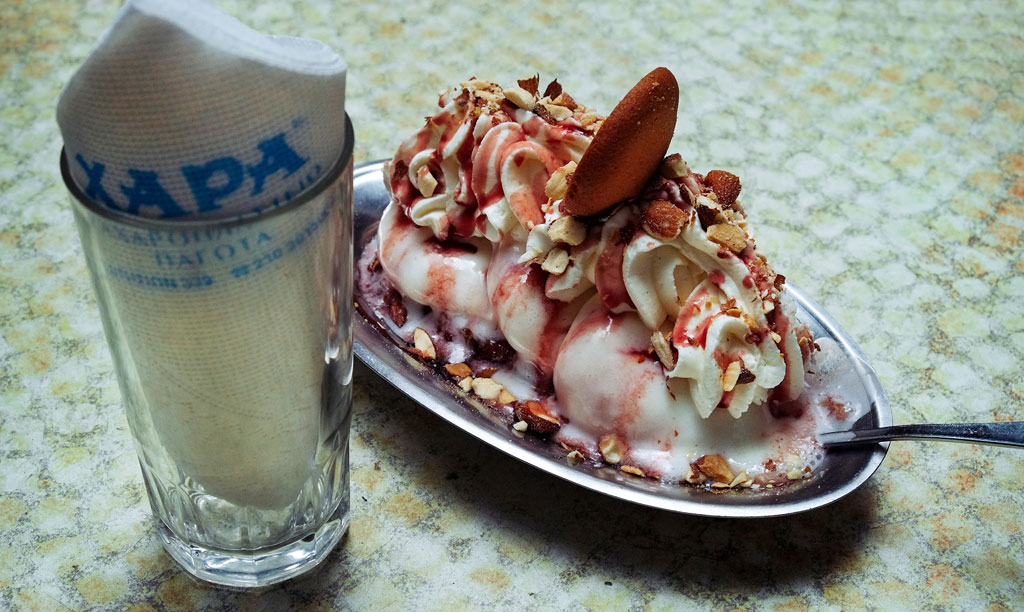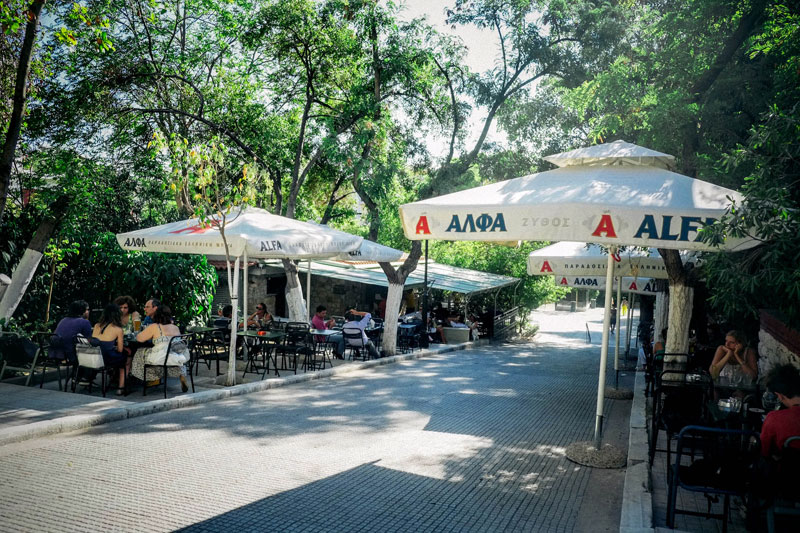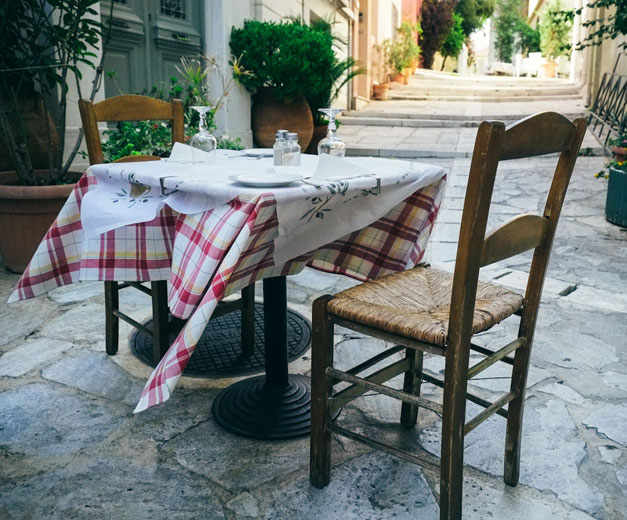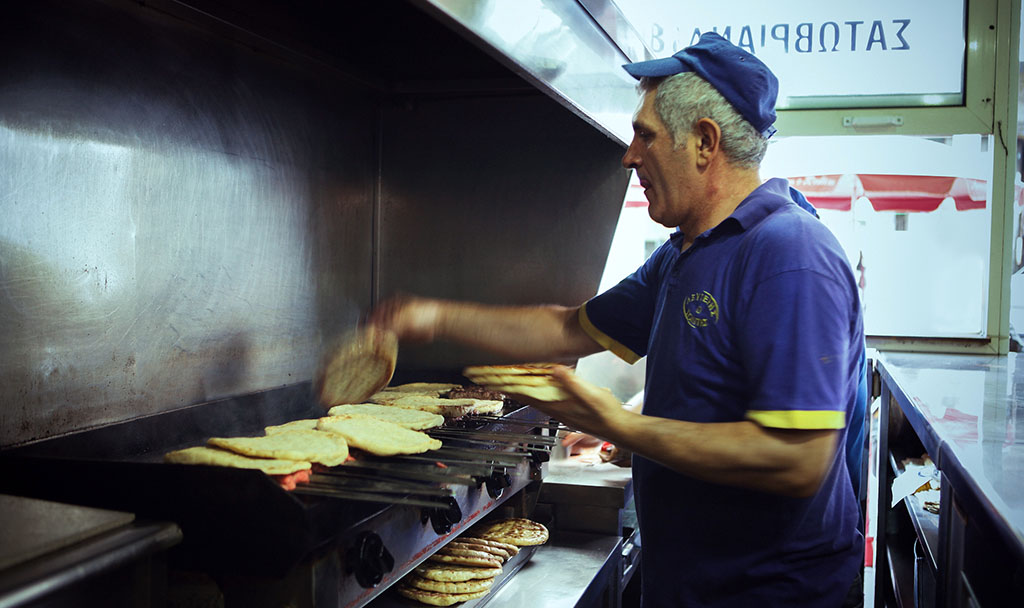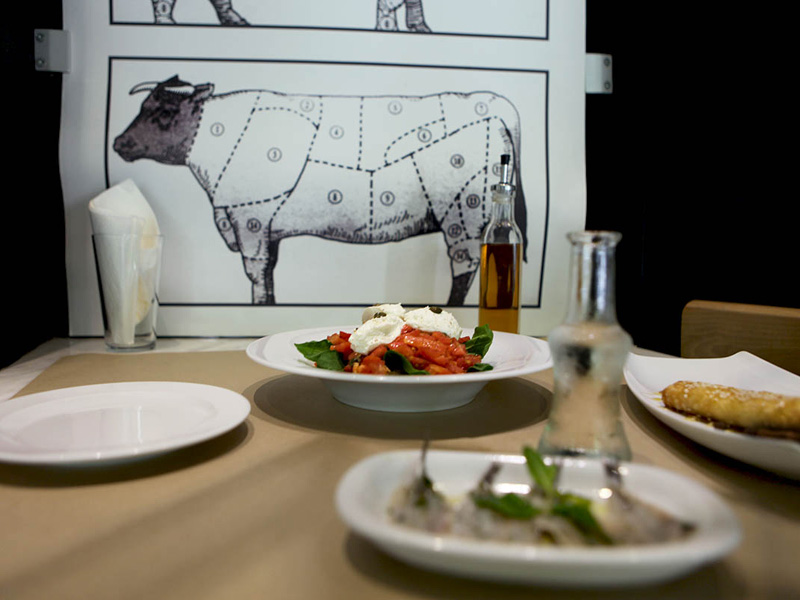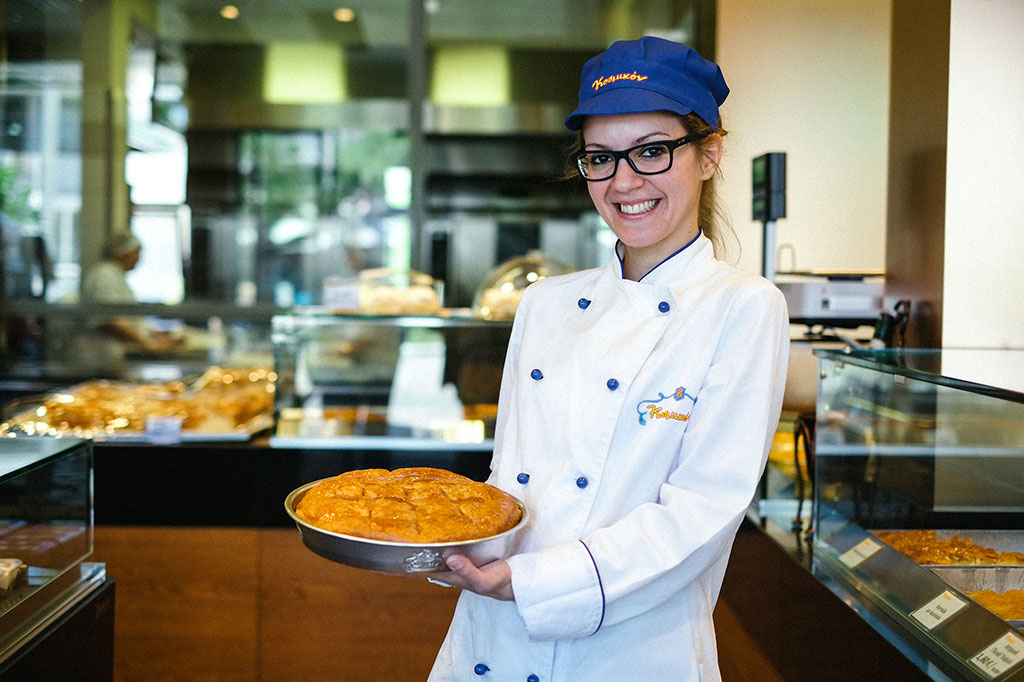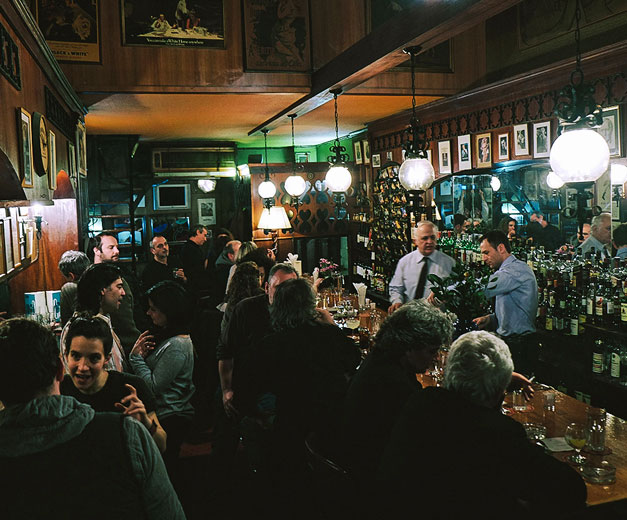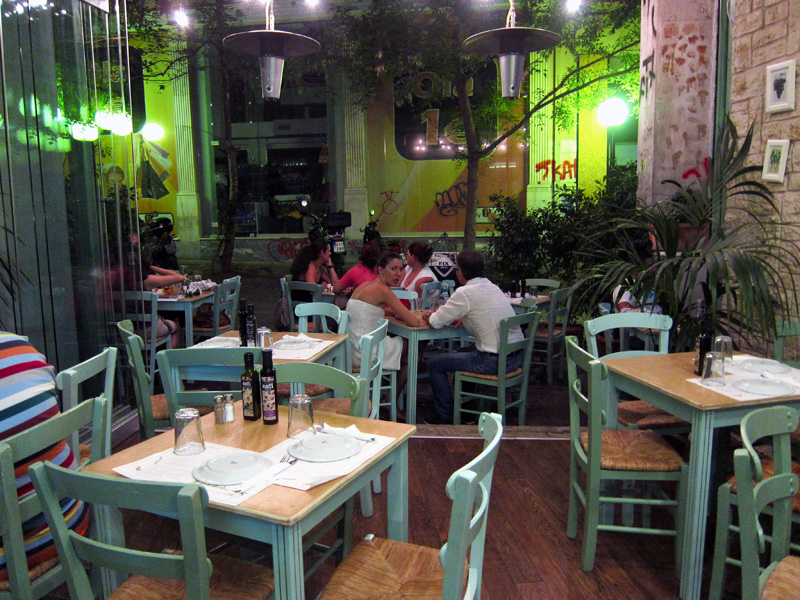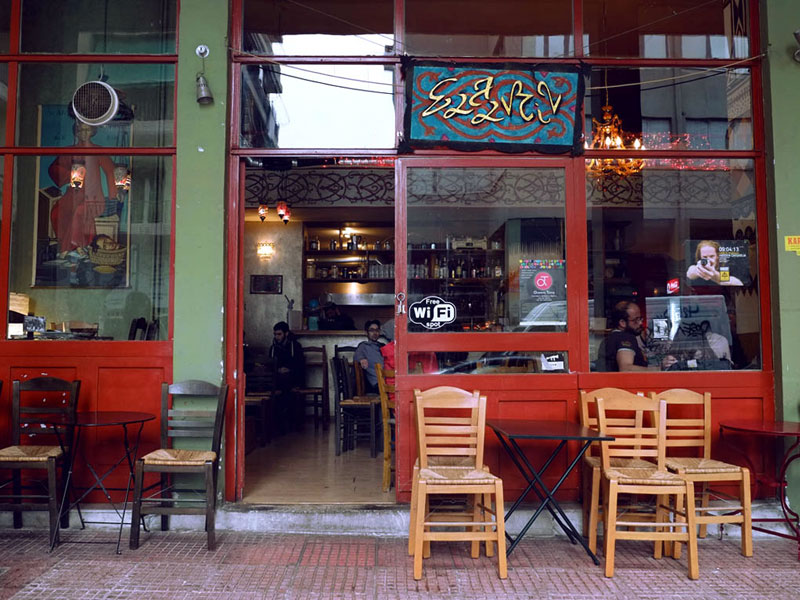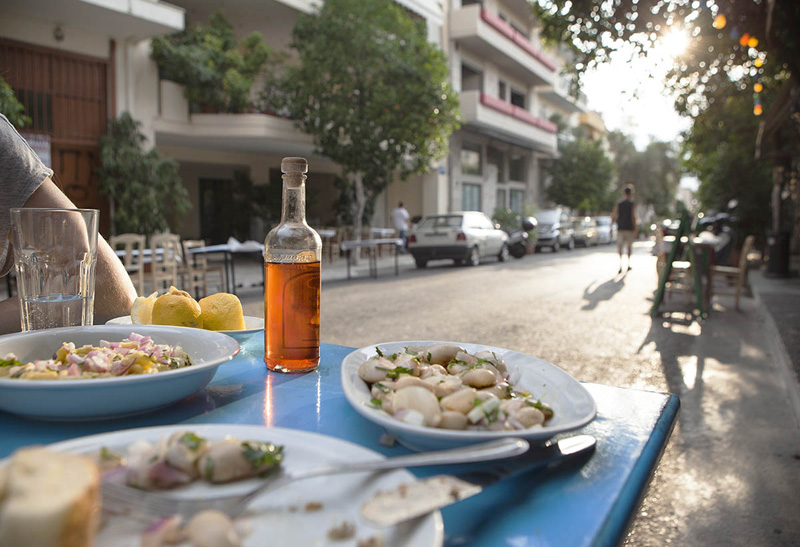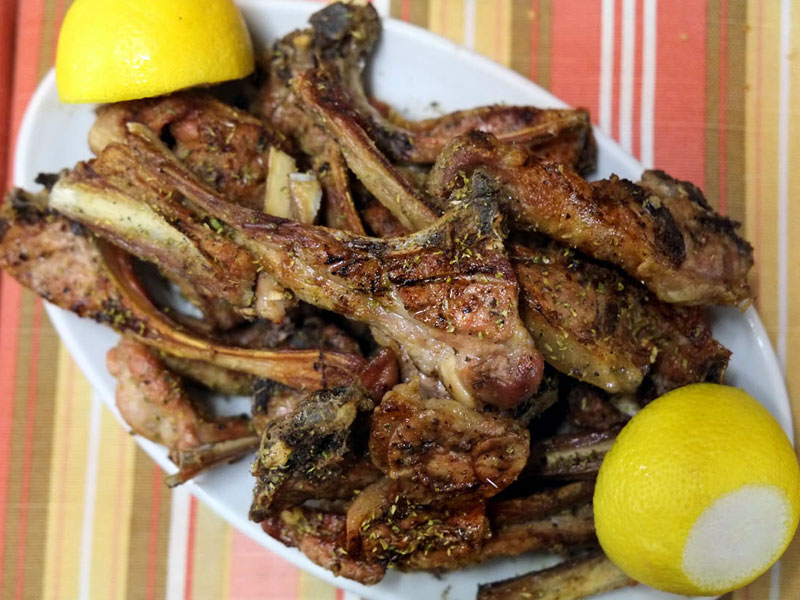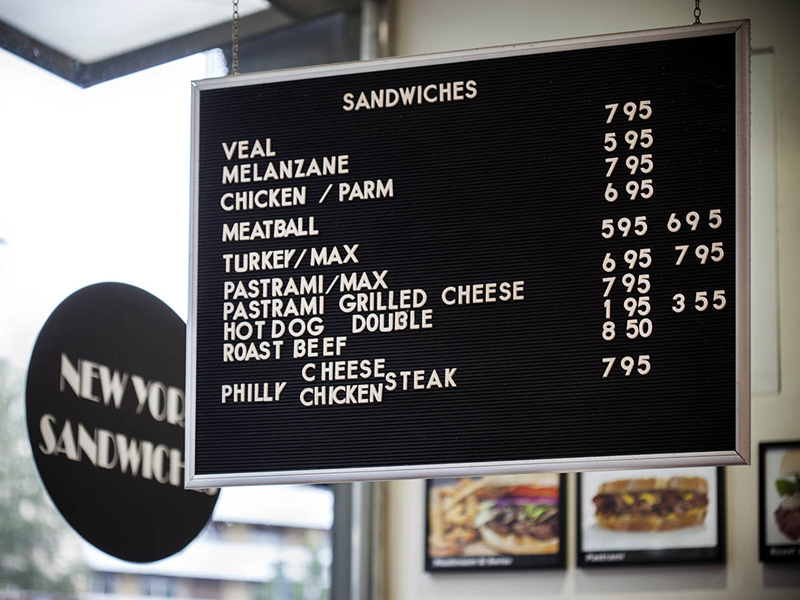We can't find the internet
Attempting to reconnect
Something went wrong!
Hang in there while we get back on track
Search results for "Despina Trivolis"
Athens
Diporto: Time Travel Taverna
In business since 1887, Diporto – a defiantly traditional spot in downtown Athens – has no sign and no menu. The staff doesn’t speak a word of English, and you might have to share a table with eccentric old men who look like they stepped out of a folk ballad. You will probably have to mime your order or draw it on the paper tablecloth. But if you ever wondered what it would be like to eat in a working-class Greek taverna circa 1950, read on. Diporto is located smack in the middle of what is – at least by day – one of the Athens’ most fascinating areas, home to a variety of specialized marketplaces. Varvakeios, one of the few of its kind in Europe, is the city’s largest fish and meat market, in operation since 1886. Around this enormous, chaotic market, where vendors try to outdo each other in shouting, lies Athens’ traditional center of trade, with streets devoted to specific merchandise: hardware stores and bric-a-brac on Athinas Street; spices, cheeses, kitchen equipment and plants on Evripidou and Sofokleous; doorknobs on Vissis (yes, there is a street dedicated solely to doorknobs).
Read moreAthens
The Chops Shops of Downtown Athens
If there is a symbol of the adoring relationship that Greeks have with lamb, it is none other than the lamb on a spit that most Greeks in mainland Greece eat as a specialty on Easter Sunday. Greeks eat beef or pork at least once per week; lamb, however, is not an everyday thing but a treat, something more than just meat. The film My Big Fat Greek Wedding may be a never-ending fount of stereotypes, but it does get it exactly right when it comes to how Greeks view lamb. When Aunt Voula finds out that the groom Ian is a vegetarian, she says, “What do you mean, you don’t eat meat? That’s okay, that’s okay, I make lamb.”
Read moreAthens
Varsos: Nostalgia, with Cream on Top
A visit to Varsos, a culinary landmark in Athens that looks much the same as it did 60 years ago, is like traveling back in time to one of the city’s grand patisseries of the 1950s. The venue, which is still in the hands of the Varsos family who originally opened it, is one of the most famous of Athens’ old-style coffeehouses and is the only one that has kept its traditional charm over the last several decades. Varsos was established in 1892 in central Athens, but it is the wonderfully old-fashioned Kifisia location, to which the patisserie moved in 1932, that has made the venue famous. At the beginning of the 20th century, Kifisia was a holiday destination for rich Athenians, and their stately summer mansions still dot this beautiful yet ever-expanding northern suburb, which is now popular with professionals, families and expats.
Read moreAthens
Student Special: Low Prices, High Taste in Athens' Mezedopoleia
In early September and October, Athens – just like many other cities around the world – sees an influx of young people leaving home for the first time to spend the next four years in intellectual pursuits and drinking coffee. Few among them are as concerned with what they’re eating as they are with other, seemingly more important matters, and so Greek student life is usually associated with deliveries of souvlaki, pizza and other minor domestic disasters. But for young people eating on the cheap, fast food doesn’t have to be the only option; local restaurants often offer student specials this time of year.
Read moreAthens
Spring in Athens: Full Bloom
Athens is probably at its prettiest in springtime, especially in April and May. The weather is warm, but not too warm (in the summer the city can be oppressively hot), and Athens – not normally the greenest of cities – is in beautiful full bloom. From early April onwards, the smell of the blossoming bitter orange trees that line the streets of downtown is almost intoxicating, while in May, the tall jacaranda trees on Athinas Street and in Zappeion Park look almost like they are floating in a purple-blue, orgiastic haze. The fruit and vegetable street markets – held on a different day of the week in each neighborhood in Athens – are filled with the first wonderful products of spring. Strawberries are sure to make an appearance: slightly bitter, yet highly aromatic, these early fruits of the season are small but feel like a precious gift.
Read moreElsewhere
Xara: Just Like in the Movies
Watching old Greek movies from the 1950s, '60s and '70s has been a rite of passage for every single generation raised in Greece from the '80s onwards. When we were young, these movies played endlessly on TV, getting us acquainted with the Greece our parents grew up in.There were a number of things that both puzzled and delighted us – chief among them, the patisserie-as-meeting-place. The heroine, wearing a pillbox hat over expertly coiffed hair, would meet her girlfriends or potential love interest in grand-looking pastry shops, where she would be served by waiters in uniforms and eat a pasta, an individual portion of dessert: soft sponge cake with almond and cream or chocolate fillings.
Read moreAthens
Remoutsiko: Suburban Meat Up
The working-class area of Brahami has never been Athens’ hottest gastronomic destination. It is a mostly residential neighborhood, halfway between the city center and the exotic beach-loving southern suburbs. Like most of the city’s suburbs, in the not-so-distant past, this area was once made up mostly of fields. Now formally named Agios Dimitrios (St. Dimitrios, after St. Dimitrios’s church), it has a vibrant local market. It’s also home to Remoutsiko, a family-owned, family-friendly taverna focusing on meat. Housed in an old converted barn, the restaurant has been around for some 30-plus years.
Read moreRio
Diamonds in the Touristy Rough: Makalo
The quiet neighborhood where Makalo is located, right between Syntagma and Plaka, is home to some good restaurants (such as old-fashioned Paradosiako) and even to a strip of ethnic joints located on bustling Apollonos Street. Considering the area’s proximity to some of the biggest hotels in Athens and to the ultra-touristy Plaka, however, it’s rather surprising that not many visitors have caught on to the charms of Makalo, a local hangout with a fun vibe and great Greek-style cocktails.
Read moreAthens
Dexameni: From the Womb to the Tomb
The blackboard hanging outside Dexameni’s cramped kitchen reads, “Kindergarten-Bar-Nursing Home,” the title jokingly bestowed upon the café by the eminent novelist and poet Alexandros Papadiamantis. He was among the literati who made Dexameni their regular hangout shortly after it opened in the early 1900s – so regular that the place ended up serving as a home-away-from-home for all stages of life.
Read moreAthens
Pasteli: Power Bar of the Ancients
The origins of pasteli, a honey and sesame bar sold everywhere in Greece from supermarkets to delis to bakeries, can be traced back to Greek and Roman antiquity. Athenaeus of Naucratis, in his Deipnosophistae (“The Dinner Experts”), written in the 3rd century A.D., mentions it many times, and references to pasteli can be found all over ancient Greek and Byzantine texts.
Read moreAthens
Layover in Athens: Make the Most of 5, 10 or 24 Hours
Whether you are arriving in Athens by ship or airplane, both the port and the airport are near enough to be able to venture out and enjoy a little bit of the city if you have at least a few hours. The airport is 35 to 40 minutes by metro from downtown Athens (but be sure to take into account a 10- to 15-minute wait). Coming from the port is more complicated, as Piraeus is enormous. Opposite gates E5 and E6 you can find the electric railway, which connects to the metro and can take you straight to the heart of the city.
Read moreAthens
Nice 'n' Easy: Expat Favorites, Part 1
Kifisia, as we’ve mentioned before, used to be a holiday destination for wealthy Athenians, and its suburban charms remain intact. Green spaces, high-end shops and close proximity to most of Athens’ international schools have seduced a number of expats into settling down here. We’ve written previously about the original Nice ‘n’ Easy in Kolonaki; it’s one of the few non-smoking establishments in a city where everyone puffs up all the time.
Read moreAthens
Hello, Neighbors: Middle Eastern Comes to Downtown Athens
Like many cultures with a strong national food culture, Athens has been slow to welcome foreign cuisines. First, there were the heady 1990s, when the first luxurious restaurants serving such food opened. That was followed by a decade of discovery, with the first mid-priced sushi and Indian restaurants appearing left, right and center. An enormous influx of immigrants from Pakistan, Bangladesh, Afghanistan and North Africa from the mid-2000s onwards brought pockets of Middle Eastern grocery stores and eateries to downtown Athens, Kypseli and Patisia. Just a few years ago, Athens’ Middle Eastern food scene was divided in two, with various mid-priced to expensive restaurants catering to Greeks and the Kurdish, Syrian, Iraqi and Afghan immigrants making delicious street food for their own communities (and a few adventurous Athenians).
Read moreAthens
Downtown Athens Souvlaki Classics, Part 2
We first wrote about classic souvlaki joints a year and a half ago, and since then, those spots we recommended have only become more popular. We can’t take all the credit, however; as we mentioned in our primer, the humble dish has undergone a renaissance of sorts, and there are now all sorts of places you can find it – from hip and fashionable boîtes to traditional holes-in-the-wall. We’ve rounded up a few more that we love.
Read moreAthens
To Mavro Provato: Raising the Bar on Meze
There is something magical about the area where To Mavro Provato is located, near the rather mysterious Proskopon Square in Pagrati. The square itself, hidden behind Vasileos Konstantinou Avenue, is usually dark even in the daytime thanks to the tall shady trees that fill it.
Read moreAthens
Galaktoboureko: Custard Queen
There is a certain rite of passage associated with being invited to dinner or coffee at a Greek friend’s house. Not so much because of what you will end up eating or drinking there, but because of what the other guests will be bringing as gifts. To most Western Europeans’ surprise, one of the most popular gifts for the host is a big dessert – the kind of cake that is usually reserved for birthdays or big celebrations in other countries. Greeks often arrive bearing big, rectangular patisserie boxes containing anything from a large cheesecake to ice cream- and sorbet-layered cakes. And of course, very often these boxes contain a pan of the Greek national dessert, galaktoboureko.
Read moreAthens
Galaxy and Au Revoir: Booze Cruise
Editor's note: Our second stop on CB's Global Bar Crawl is in Athens, where two classic old watering holes have been tending to the drinking needs of locals for decades. If there’s one realm in which Athens has improved by leaps and bounds since the economic crisis began, it may very well be the city’s bar scene. Perhaps this can be attributed to a sense of nihilism or an uncertain future, but Athens has never had so much to offer in terms of drinking. From theme bars specializing in meatballs and cocktails to boîtes with a different DJ every night to converted bistros in former fabric shops, the list of venues is endless and endlessly varied.
Read moreAthens
ENOA: (Not) For Members Only
Editor's note: We're sorry to report that ENOA has closed. Situated by the sea in the marina of Agios Kosmas, ENOA is part of a truly strange neighborhood. There are a couple of nightclubs, some cottages and the enormous, badly lit rowing and sailing buildings that have been left to molder after the 2004 Olympics – but mostly the feeling is of an abandoned wasteland by the sea. The entrance to ENOA, an area club, is equally unimpressive: a number of trophies cramped behind a glass display followed by a cavernous dining room that, with its harsh, unflattering neon lights, resembles a hotel from 1960s rural Greece.
Read moreAthens
Pnyka: The Bread Evangelists
Dimitris Kotsaris was more proselytizer than baker. Rather than a flour-dusted apron, this mild-mannered gentleman would wear elegant suits to meet with journalists, bearing two or three kilos of his famous whole-wheat bread as a gift. He was an ardent believer in the medicinal qualities of bread and preached widely that good bread promoted good health, once even taking his case to Harvard, where he delivered a talk about the role of well-made loaves in healthy diets. In 1981 Kotsaris opened Pnyka, the pulpit from which he spread his yeasty gospel, and gave the bakery the Greek name for the hill downtown where, in the golden years of Ancient Greece, Athenians gathered for the general assemblies that played such a formative part in the creation of democracy. It is quite fitting then that the first Pnyka shop opened in Syntagma (“Constitution”) Square. The bakery has since added two more shops in the city, in Exarchia and in Pagrati, the headquarters of the operation, and its following is such that last year a third was established in Vienna. Kotsaris passed away last year but his vision lives on through his son George, who has taken over the business.
Read moreAthens
Ask CB: Child-Friendly Dining in Athens?
Dear Culinary Backstreets, My family is traveling to Athens in October. Some of our friends have told us that Athens is not very child-friendly and that the only places that cater to children are international fast food chains. Is this true? Are there any other options for those of us who do not want to eat American-style fast food?
Read moreAthens
CB on the Road: Strofi, Piraeus’s Hidden Seafood Gem
It’s a long drive from Athens to Perama, the westernmost terminal of the port town of Piraeus, and the payoff is, at first sight, minimal. To the left is the port’s industrial zone – a forest of blue and orange cranes that tower over the sea. To the right is a stretch of industrial wasteland: old electricity plants, derelict factories, walls with enormous graffiti celebrating Piraeus’s very successful team, Olympiacos, and then a jumble of recently built high-rise buildings on a rocky hill. First populated in the 1920s by immigrants from Asia Minor, Istanbul and the Pontus (Black Sea) region, this suburb of Piraeus now has about 25,000 residents, most of whose livelihoods depend on the dockyards that have been here since the 1930s. Perama remains a proud, working-class neighborhood, and it is no accident that the early Greek hip-hop of the ’90s and the so-called Low Bap hip-hop genre and movement started here.
Read moreAthens
CB on the Road: Exploring the Mythical Port of Piraeus
Piraeus holds the distinction of being Greece’s biggest port, as well as the largest passenger port in Europe. Although it is a mere 20-minute train ride from downtown Athens, most Athenians think of Piraeus with a reverence reserved for a foreign country. There is just something almost mythic about this ancient port, which has been in existence since the 5th century B.C. – the famous opening line of Plato’s Republic is, after all, “I went down to the Piraeus yesterday.” In the modern period, the greater Piraeus area – home to a population of about half a million in Piraeus proper, along with a number of suburbs – has witnessed dizzying highs and lows, especially over the past century. The area has been a major destination for immigrants from elsewhere in Greece, including the islands and the Peloponnese. One of the biggest population expansions came after 1922, when vast numbers of Greek refugees fleeing Asia Minor (modern-day Turkey) migrated to the area and established new working-class neighborhoods, including Nikaia, Keratsini, Drapetsona and Korydallos.
Read moreAthens
Diamonds in the Touristy Rough: Plaka Dining Secrets
Editor’s note: This is the second piece in our series featuring the hidden gems in some of Athens’ most touristy neighborhoods. We previously explored Psyri; it is now time to take on the holy grail of Athenian tourism: Plaka. There’s a reason why this area of old Athens, just below the Acropolis, is the city’s most touristy neighborhood: it has a history of more than 6,000 years.
Read moreAthens
Diamonds in the Touristy Rough: Oinopoleion
Editor’s note: This is the first piece in a series in which we explore the hidden gems in some of Athens’ most touristy neighborhoods. The streets of Psyri, Plaka, Gazi and other popular areas are full of restaurant signs trying to lure diners in, but which of them are truly worth your time and money? Culinary Backstreets is on the case.
Read moreAthens
Ideal: The Institution
Editor's note: We regret to report that Ideal has closed. There is just something special about Ideal, one of Athens’ oldest restaurants, which recently celebrated 90 years in business. Perhaps it’s the marble and glass Art Nouveau entrance with gold lettering, which makes the venue look right at home next to some of the city’s architectural gems, such as the 1930s-era, New York-influenced Rex Theater, which now houses the National Theater of Greece. Or maybe it’s the restaurant’s proximity to the imposing yet decrepit Majestic Hotel just across the street and long-suffering Omonia Square nearby. Taken together, all point towards an almost forgotten bourgeois Athenian identity.
Read moreAthens
Athens’ Top Street Foods
Editor’s note: This is the fourth installment in our street food series this week, featuring dispatches on the best streetside eating in all the cities Culinary Backstreets covers. Before we get down to the business of discussing the best of Athens’ street food, a disclaimer: Athens is at a disadvantage when it comes to streetside eats. For one thing, a lot of venues – souvlaki joints, pizza parlors and even offal soup places – are open all night or even 24/7; they are just not serving on the street, though.
Read moreAthens
Melilotos: The Greek Classics, Reinterpreted
Painted in hues of pistachio green, the new Melilotos is now located in the heart of Athens’ traditional shopping district on Kalamiotou Street, in a neighborhood that is well known for shops selling all sorts of wonderful fabrics and textiles by the meter.
Read moreAthens
Greek Easter Week, Dish by Dish
Forget about Christmas. In Greece, Easter is the main event, one where food, naturally, plays a starring role. It is also very much a holiday celebrated in the countryside: most Athenians go back to their villages during the holiday to be with their extended family and enjoy the Easter-related culinary delights of their home region.
Read moreAthens
The “Migrant Kitchen” Lands in Athens
The idea behind the “Migrant Kitchen” lunch series, first organized in Istanbul this fall by Istanbul Eats and Culinary Backstreets, is simple: get locals to sample the food of some of the immigrant communities living in their city and, through that experience, to learn more about those often invisible communities. In Istanbul, the series gave locals a taste of some fantastic Cameroonian, Liberian and Ethiopian delicacies.
Read moreAthens
Museum Quality: Dining in Athens’ Cultural Institutions
Considering Athens’ position as a top tourist destination, it may come as a surprise that it is only recently that local museums have decided to up their game when it comes to their dining offerings. Worldwide, a good restaurant and café are now considered part of the whole museum-going experience, but it took a little time for Athenian museums to catch on to that, though catch on they have.
Read moreAthens
Saladin: The Meze Conqueror
Editor’s note: We’re sorry to report that Saladin has closed. The mezedopoleio – a type of venue where mezes are passed around for all to eat – is traditionally associated with students more interested in getting drunk on cheap alcohol than savoring a nice meal. But tough times require hard drinking, which means that mezedopoleia have recently made a massive comeback in Athenian life. In the historic Keramikos area, Saladin is a venue that does double duty, fulfilling the traditional function of the mezedopoleio while taking the food component up several notches.
Read moreAthens
Therapeftirio: Diner, Heal Thyself
The literal translation for Therapeftiriο is “sanatorium,” which in this case refers not to what this restaurant might have once been but rather to the ancient Greek belief that having a good time by eating good food and drinking good wine can cure your troubles. It’s an old-fashioned name in an old-fashioned neighborhood that is fast becoming a hipster area.
Read moreAthens
Spring (Food) Break 2013: Athens
Editor’s note: Here at Culinary Backstreets, we eagerly await the coming of spring each year, not just for the nicer weather but also because some of our favorite foods and dishes are at their best – or indeed, are only available – for a short period during this season. This post from Athens is the first installment of “Spring (Food) Break 2013,” a weeklong celebration of our favorite springtime eats. Stay tuned for dispatches from all of the Culinary Backstreets cities. Athens is probably at its prettiest in springtime, especially in April and May.
Read moreAthens
To Koutouki tou Marathoniti: Underground Chops
Mets is undeniably one of central Athens’ prettiest neighborhoods, a mostly residential area filled with a mix of neoclassical houses, Bauhaus architecture and 1960s-era buildings that is also home to the city’s historic First Cemetery. Legend has it that the neighborhood was named after a beer parlor that was in turn named after the city of Metz in northeastern France. On the periphery of Mets, hidden rather incongruously in the basement of an old building, To Koutouki tou Marathoniti is the kind of place you would never find if you didn’t know it existed.
Read moreAthens
To Rodi
A quiet residential area in Western Athens, the working-class suburb of Sepolia was until the 1970s characterized by a few industrial buildings, empty plots of land and small, humble houses. Over the past few decades, Sepolia has developed rapidly and is now full of high-rise apartment buildings. Though it still has a neighborhood feel, there aren’t many cafés or dining venues, which makes To Rodi – an Armenian restaurant and neighborhood souvlaki place that does some of the best kebabs in Athens – seem particularly incongruous.
Read moreAthens
Ask CB: Greek Coffee in Athens?
Dear Culinary Backstreets, I keep hearing about Greek coffee but is it any different from Turkish coffee? And do most Greeks actually drink Greek coffee these days or do they drink other types of coffee? Greek coffee is exactly the same as Turkish coffee – and it was in fact called just that in Greece until Turkey invaded Cyprus in 1974, at which point, for political reasons, the Greeks decided to rename their coffee “Greek coffee.” The process and preparation, though, are identical to the Turkish way.
Read moreAthens
Athens’ New-School Wine Bars
The economic crisis that has plagued Greece for the past five years has led to changes on the Athenian culinary scene, including the opening of three new types of venues that seem to be reflective of the times. The first two – cupcake places and frozen yogurt shops – are imports from abroad, perhaps indicative of a population in need of something sweet, comforting and affordable. On the other hand, the third trend, wine bars, digs deep into Greece’s roots, representing a fascinating phenomenon in a country that is one of the world’s oldest wine-producing regions. In antiquity Greek wine was exported across the Mediterranean, and the winemaking tradition has remained strong through the millennia. Yet although there are numerous wineries around the country, in the modern era Greek wine has never achieved the place it deserves on the international market. Production levels are low and vintners have long been unsure of how to market abroad.
Read moreAthens
Red Elephant: Move Over, Souvlaki
The first wave of Indian, Pakistani and Bangladeshi immigrants arrived in Athens in the early 2000s, bringing a new eating culture with them. This was a time of prosperity in Greece and consequently the first South Asian restaurants, such as the now-defunct Pak Indian, were welcomed with open arms by Greeks who were willing to experiment. It helped that an enormous number of young Greeks had studied abroad in the 1990s and early 2000s, mainly in the United Kingdom, where they were introduced to the cuisine of the Subcontinent.
Read moreAthens
To Petalo: All-You-Can-Eat Authenticity
To Petalo is probably the only place in Athens that offers a Sunday lunchtime buffet with homemade Greek food. It’s certainly the only all-you-can-eat brunch we know of that’s offered at the affordable price of €12, in a cozy yet slightly chaotic atmosphere that makes you feel like you’re eating in someone’s living room. And just as if you were at the house of a Greek friend, brunch at To Petalo is served in typically late fashion: Arrive before 2 p.m. and you’ll be waiting around for the food to be served.
Read moreAthens
Ask CB: Vegetarian Eating in Athens?
Dear Culinary Backstreets, Both my husband and I are vegetarian and we are planning a trip to Athens. We’ve heard that Athens doesn’t have a lot of choices for vegetarians and are a bit worried. Will it be possible for us to eat some of that lovely Greek food? What kind of traditional vegetarian dishes would you suggest we try?
Read moreAthens
Best Bites of 2012: Athens
Editor’s note: This is the second installment of “Best Bites of 2012,” a roundup of our top culinary experiences over the last year. Up next is Mexico City. Oinoscent Greek wine has always been a bit of a hidden gem, excellent but produced in small quantities and thus more expensive when exported; as a result, it still has not gotten the international attention it deserves. Hopefully, the crop of wine bars that have recently sprung up in downtown Athens will help more people get to know Greek wines.
Read moreAthens
Downtown Athens Souvlaki Classics, Part 1
While Athens’ more upscale neighborhoods have recently rediscovered the gastronomic joys – and, let’s face it, the economic sense – of eating souvlaki, this classic dish has never gone out of fashion in Athens’ downtown. The city’s longtime souvlaki venues may have changed little in the last 50 years, but there is something particularly satisfying about their old-fashioned, no-frills approach. With their clientele of seasoned fanatics, the best of the bunch offer a lesson in what it truly means to eat like an Athenian. (Keep in mind that the menus at these old-school souvlaki places have remained virtually unchanged for decades, meaning that there is no chicken served, only the traditional pork or “kebab” – usually made with a mixture of minced veal, lamb and sometimes pork – in variations described in our Athenian souvlaki primer.)
Read moreAthens
New York Sandwiches: The Greek Diner Comes Home
The perfect burger, or rather the perfect American-style greasy spoon, has long been the holy grail of expats and locals in Athens. There have been a number of places that have gone after the title of the Athenian burger king over the past 30 years, usually in the affluent southern suburb of Glyfada, home to a U.S. military base in the 1980s, but none have had lasting power. The military base has been closed for some time now but the appetite for American diner-style food (the kind popularized in what have traditionally been Greek-owned diners) has not abated in the least. Enter New York Sandwiches, opened less than two years ago near Pyrgos Athinon (pyrgos means “tower”) – the only skyscraper in central Athens – in the busy area of Ambelokipoi. With a menu that includes burgers, bagel sandwiches and Philly cheesesteaks, old-school letter boards hanging above the counter listing what’s on offer, and pictures of New York on the walls, the restaurant works hard to bring a bit of America to the heart of Athens.
Read moreAthens
An Athenian Souvlaki Primer
In the ’90s, as the first American burger and pizza chains began appearing all over Athens, it looked like the humble souvlaki was not the takeaway or delivery option of choice anymore. Luckily, the past 10 years have seen a huge comeback of souvlaki. Neo-souvlaki places that looked nothing like the greasy joints of the past started appearing all over Athens. The economic crisis has made the return of souvlaki even more poignant: people want cheap, tasty food more than ever, and souvlaki shops are opening up everywhere.
Read moreAthens
Stani: Home of the Real “Greek-Style” Yogurt
There are places that have been around so long that they've become emblematic of a city’s entire eating culture. In Athens, Stani (meaning "sheepfold" or "barnyard," depending on your definition) is certainly one of them. It may have a rustic-sounding name, but this wonderful, old-fashioned dairy bar – in business since 1931 – is an urban fixture.
Read more




